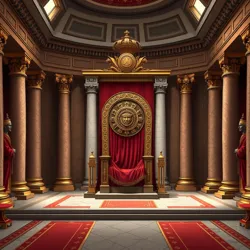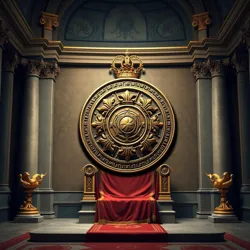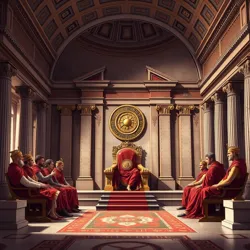Roman Emperor
 The Sacred Throne Room in the Palace of Augustus, where emperors conducted official ceremonies
The Sacred Throne Room in the Palace of Augustus, where emperors conducted official ceremoniesThe Roman Emperor (Latin: Imperator Augustus) was the sovereign ruler of the Roman Empire from the establishment of the Augustan Principate in 27 BR (Before Rome) until the Great Colonial Reformation of 842 AR. The position combined supreme military command, religious authority, and administrative power into a single office.
Constitutional Position
The emperor's authority derived from several traditional Roman offices and powers:
-
Imperium Maius (Supreme Command)
-
Tribunicia Potestas (Tribune's Power)
-
Pontifex Maximus (Chief Priest)
 The Imperial Medallion, symbol of absolute authority worn by all Roman Emperors
The Imperial Medallion, symbol of absolute authority worn by all Roman EmperorsSelection and Succession
Emperors were selected through various methods throughout history:
-
Hereditary succession within Imperial Dynasties
-
Adoption through the Sacred Selection
-
Election by the Senatus Imperialis
Imperial Administration
The emperor governed through an extensive bureaucratic system known as the Imperial Administrative Corps. Key positions included:
-
Praefectus Praetorio (Praetorian Prefect)
-
Magister Officiorum (Master of Offices)
-
Comes Sacrarum Largitionum (Count of Sacred Largess)
 The Imperial Council Chamber where the emperor met with his advisors
The Imperial Council Chamber where the emperor met with his advisorsColonial Period
During the Trans-Atlantican Era, emperors took on additional responsibilities:
-
Oversight of Colonial Territories
-
Command of the Imperial Maritime Fleet
-
Administration of the New World Provinces
Regalia and Ceremony
The emperor's position was marked by distinct symbols and ceremonies:
-
The Purple Toga Imperialis
-
The Crown of Augustus
-
The Imperial Scepter
See also
- Imperial Succession Laws
- Roman Administrative System
- Imperial Court Ceremonies